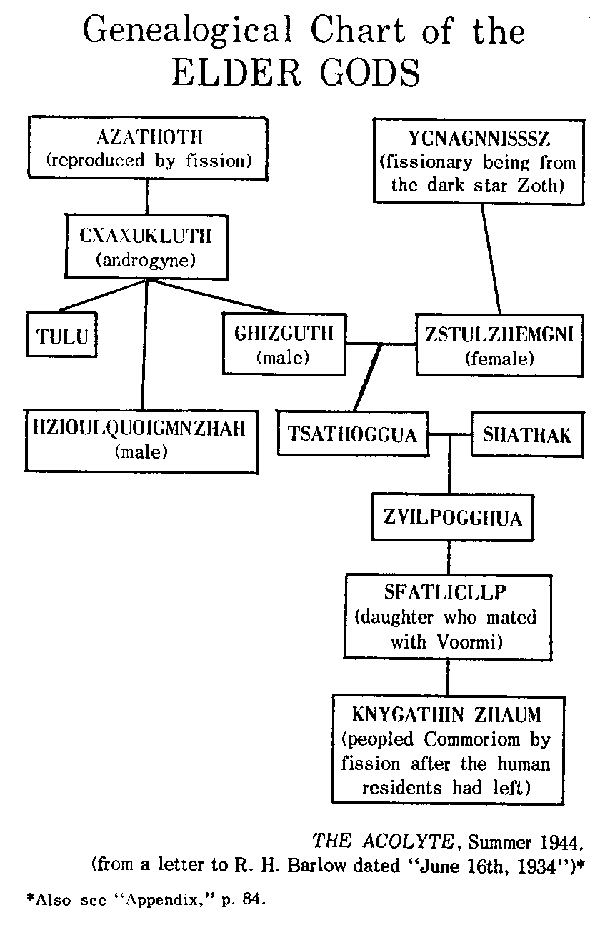The Family Tree of the Gods
Clark Ashton Smith
I have filled out the "style-sheet" with such annotations and details concerning Tsathoggua as I am at present able to furnish. Some of these have required considerable delving into the Parchments of Pnom (who was the chief genealogist as well as a noted prophet) and I am well aware that certain of my phonetic renderings from the Elder Script are debatable. You raise some interesting points with your questions. Azathoth, the primal nuclear chaos, reproduced of course only by fission; but its progeny, entering various outer planets, often took on attributes of androgynism or bisexuality. The androgynes, curiously, required no coadjutancy in the production of offspring; but their children were commonly unisexual, male or female. Hzioulquoigmnzhah, uncle of Tsathoggua, and Ghizghuth, Tsathoggua's father, were the male progeny of Cxaxukluth, the androgynous spawn of Azathoth. Thus you will note a trend toward biological complexity. It is worthy of record, however, that Knygathin Zhaum, the half-breed Voormi, reverted to the most primitive Azathothian characteristics following the stress of his numerous decapitations. I have yet to translate the terrible and abominable legend telling how a certain doughty citizen of Comnioriom (not Athammaus) returned to the city after its public evacuation, and found that it was peopled most execrably and numerously by the fissional spawn of Knygathin Zhaum, which possessed no vestige of anything human or even earthly.
Ech-Pi-El, I am sure, can furnish much fuller data concerning the genesis of Tulu (Cthulhu) than I am able to offer. It would seem, from the rather oblique references of Pnom, that Tulu was a cousin of Hzioulquoignmzhah, but was somewhat closer to the Azathothian archetype than Hzioulquoigmnzhah. The latter god, I learn, together with Ghisghuth, was horn of Cxnxukluth in a far system. Cxaxukluth came en famille (family already included Ghisguth's wife, Zstylzhemgni, and the infant Tsathoggua) to Yuggoth (where, I may add, Cxaxukluth has most mercifully continued to sojourn throughout the aeons). Hzioulquoigmnzhah, who found its parent slightly uncongenial owing to its cannibalistic habits, emigrated to Yaksh (Neptune) at an early age; but, wearying of the peculiar religious devotions of the Yakshians, went on to Cykranosh, in which he preceded by several aeons his nephew Tsathoggua. (Tsathoggua, with his parents, lingered a long while in Yuggoth, having penetrated certain central caverns beyond the depredations of Cxaxukluth.) Hzioulquoigmnzh, a rather reflective and philosophic deity, was long worshipped by the quaint peoples of Cykranosh but grew tired oi them even as of the Yakshians; and he had permanently retke~ from active life at the time of his encounter with Eibon as relatec in The Door To Saturn. No doubt he still resides in the columned cavern, and still quenches his thirst at the lake of liquid metal-- a confirmed bachelor, and sans offspring.
My account of Tsathoggua's advent can readily be reconciled with the references in The Mound. Tsathoggua, travelling through another dimension than the familiar three,first entered the Earth by means of the lightless inner Gulf of N'Kai; and he lingered there for cycles, during which his ultraterrestrial origin was not suspected. Later, he established himself in caverns nearer to the surface, and his cult thrived; but after the coming of the ice he returned to N'Kai. Thereafter, much of his legend was forgotten or misunderstood by the dwellers in the red-litten Caverns of Yoth and blue-litten Caverns of K'n-Yan. Through such mythopoetic variations, GIl'-Hathaa-Ynn came to tell the Spaniard Zamarcoma that only the images of Tsathoggua, and not Tsathoggua himself, had emerged from the inner world. . . .
